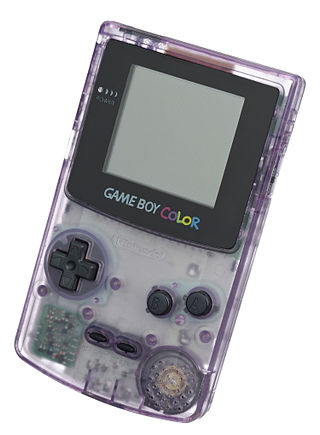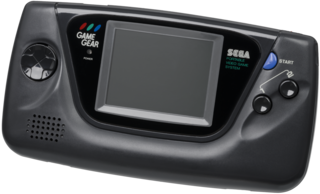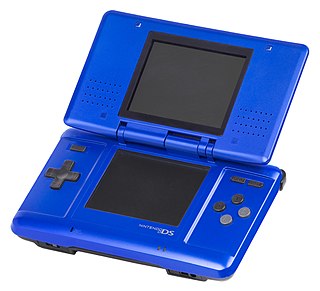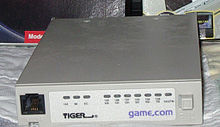
The Atari Lynx is a hybrid 8/16-bit fourth-generation hand-held game console released by Atari Corporation in September 1989 in North America and 1990 in Europe and Japan. It was the first handheld game console with a color liquid-crystal display. Powered by a 16 MHz 65C02 8-bit CPU and a custom 16-bit blitter, the Lynx was more advanced than Nintendo's monochrome Game Boy, released two months earlier. It also competed with Sega's Game Gear and NEC's TurboExpress, released the following year.

The Game Boy Advance (GBA) is a 32-bit handheld game console developed, manufactured and marketed by Nintendo as the successor to the Game Boy Color. It was released in Japan on March 21, 2001, in North America on June 11, 2001, in the PAL region on June 22, 2001, and in mainland China as iQue Game Boy Advance on June 8, 2004. The GBA is part of the sixth generation of video game consoles. The original model was followed in 2003 by the Game Boy Advance SP, a redesigned model with a frontlit screen and clamshell form factor. A newer revision of the SP with a backlit screen was released in 2005. A miniaturized redesign, the Game Boy Micro, was released in September 2005.

The Game Boy Color is an 8-bit handheld game console, manufactured by Nintendo, which was released in Japan on October 21, 1998 and to international markets that November. It is the successor to the Game Boy and is part of its product line. Critics like IGN consider it more akin to a hardware revision than a next generation product.

A handheld game console, or simply handheld console, is a small, portable self-contained video game console with a built-in screen, game controls and speakers. Handheld game consoles are smaller than home video game consoles and contain the console, screen, speakers, and controls in one unit, allowing people to carry them and play them at any time or place.

The Neo Geo Pocket (NGP) is a monochrome handheld game console released by SNK. It was the company's first handheld system and is part of the Neo Geo family. It debuted in Japan in late 1998 but never saw a western release, being exclusive to Japan and Hong Kong.

The Game Gear is an 8-bit fourth generation handheld game console released by Sega on October 6, 1990, in Japan, in April 1991 throughout North America and Europe, and during 1992 in Australia. The Game Gear primarily competed with Nintendo's Game Boy, the Atari Lynx, and NEC's TurboExpress. It shares much of its hardware with the Master System, and can play Master System games through the use of an adapter. Sega positioned the Game Gear, which had a full-color backlit screen with a landscape format, as a technologically superior handheld to the Game Boy.

The WonderSwan is a handheld game console released in Japan by Bandai. It was developed by Gunpei Yokoi's company Koto Laboratory and Bandai, and was the last piece of hardware Yokoi developed before his death in 1997. Released in 1999 in the sixth generation of video game consoles, the WonderSwan and its two later models, the WonderSwan Color and SwanCrystal were officially supported until being discontinued by Bandai in 2003. During its lifespan, no variation of the WonderSwan was released outside of Japan.

The Genesis Nomad, also known as Sega Nomad, is a handheld game console manufactured by Sega and released in North America in October 1995. The Nomad is a portable variation of the Sega Genesis home video game console. It could also be used with a television set via a video port. It was based on the Mega Jet, a portable version of the home console designed for use on airline flights in Japan.
Tiger Electronics Ltd. was an independent American toy manufacturer best known for its handheld electronic games, the Furby, the Talkboy, Giga Pets, the 2-XL robot, and audio games such as Brain Warp and the Brain Shift. When it was an independent company, Tiger Electronics Inc., its headquarters were in Vernon Hills, Illinois. It has been a subsidiary of Hasbro since 1998.

The Nintendo DS is a foldable handheld game console produced by Nintendo, released globally across 2004 and 2005. The DS, an initialism for "Developers' System" or "Dual Screen", introduced distinctive new features to handheld games: two LCD screens working in tandem, a built-in microphone and support for wireless connectivity. Both screens are encompassed within a clamshell design similar to the Game Boy Advance SP. The Nintendo DS also features the ability for multiple DS consoles to directly interact with each other over Wi-Fi within a short range without the need to connect to an existing wireless network. Alternatively, they could interact online using the now-defunct Nintendo Wi-Fi Connection service. Its main competitor was Sony's PlayStation Portable during the seventh generation of video game consoles.

The TurboExpress is an 8-bit handheld game console by NEC Home Electronics, released in late 1990 in Japan and the United States, branded as the PC Engine GT in Japan and TurboExpress Handheld Entertainment System in the U.S. It is essentially a portable version of the TurboGrafx-16 home console that came two to three years earlier. Its launch price in Japan was ¥44,800 and $249.99 in the U.S.
The history of video game consoles, both home and handheld, had their origins in the 1970s. The concept of home consoles used to play games on a television set was founded by the 1972 Magnavox Odyssey, first conceived by Ralph H. Baer in 1966. Handheld consoles bore out from electro-mechanical games that had used mechanical controls and light-emitting diodes (LED) as visual indicators. Handheld electronic games had replaced the mechanical controls with electronic and digital components, and with the introduction of Liquid-crystal display (LCD) to create video-like screens with programmable pixels, systems like the Microvision and the Game & Watch became the first handheld video game consoles, and fully realized by the Game Boy system.
A dedicated console is a video game console that is limited to one or more built-in video game or games, and is not equipped for additional games that are distributed via ROM cartridges, discs, downloads or other digital media. Dedicated consoles were very popular in the first generation of video game consoles until they were gradually replaced by second-generation video game consoles that use ROM cartridges.

The Game Boy is an 8-bit fourth generation handheld game console developed and manufactured by Nintendo. It was first released in Japan on April 21, 1989, in North America later the same year, and in Europe in late 1990. It was designed by the same team that developed the Game & Watch series of handheld electronic games and several Nintendo Entertainment System (NES) games: Satoru Okada, Gunpei Yokoi, and Nintendo Research & Development 1.

The Lost World: Jurassic Park is the title of several different video games released for handheld video game consoles in 1997. Four versions, each with their own gameplay variations, were developed and published by various companies for the Sega Game Gear, Nintendo's Game Boy, and Tiger Electronics' game.com and R-Zone consoles. Each version is based on the 1997 film of the same name.

The R-Zone is a portable game console developed and manufactured by Tiger Electronics. The R-Zone was shown at the American International Toy Fair in February 1995, and was released later that year. The R-Zone was panned by critics, and was also a commercial disaster, with its lifespan lasting only two years before being discontinued in 1997. Although the R-Zone was not designed to compete directly with any other handhelds, it marked Tiger Electronics' first multi-game entry into the portable electronic game market.

The Japanese multinational consumer electronics company Nintendo has developed seven home video game consoles and multiple portable consoles for use with external media, as well as dedicated consoles and other hardware for their consoles. As of September 30, 2021, in addition to Nintendo Switch, Nintendo has sold over 863.07 million hardware units.
Nintendo 64 accessories are first-party Nintendo hardware—and third-party hardware, licensed and unlicensed. Nintendo's first-party accessories are mainly transformative system expansions: the 64DD Internet multimedia platform, with a floppy drive, video capture and editor, game building setup, web browser, and online service; the controller plus its own expansions for storage and rumble feedback; and the RAM-boosting Expansion Pak for big improvements in graphics and gameplay. Third-party accessories include the essential game developer tools built by SGI and SN Systems on Nintendo's behalf, an unlicensed SharkWire online service, and unlicensed cheaper counterparts to first-party items. In the fifth generation of video game consoles, the Nintendo 64 had a market lifespan from 1996 to 2002.
The Retroid Pocket 2 is an Android-based handheld video game console created in China by GoRetroid and released in September 2020. An emulation console, it is capable of playing games from various handheld and non-handheld systems, including all consoles up to the Dreamcast. It cannot play normal video game cartridges and is a ROM-only device, legal in China but a legal grey area in the United States, where it is often imported. It is the successor to the Retroid Pocket, and has emerged as a prominent handheld console for retrogaming alongside the Anbernic RG351. It is priced at US$84.99, however, an second version, the Retroid Pocket 2+, was released in early 2022, featuring a touchscreen, stronger CPU and RAM, and higher-quality buttons, at a slightly higher price point of US$99. An third version, the Retroid Pocket 2S, was released in mid 2023, featuring even stronger CPU and RAM. Critics praised its low price and build quality, but its outdated Android version, front end interface, low battery life, and offset analog sticks were noted as points of contention.

















